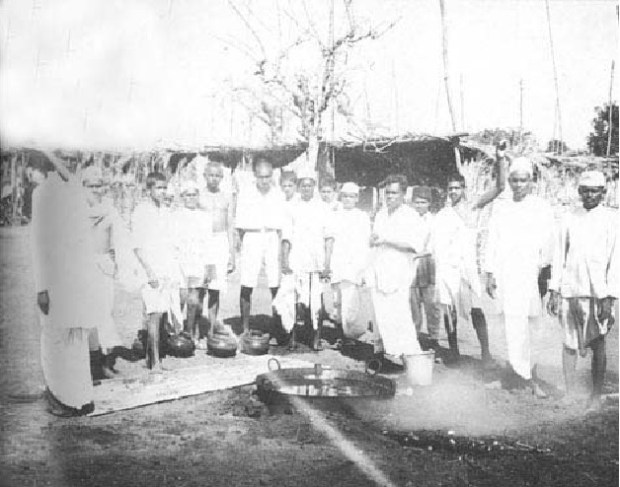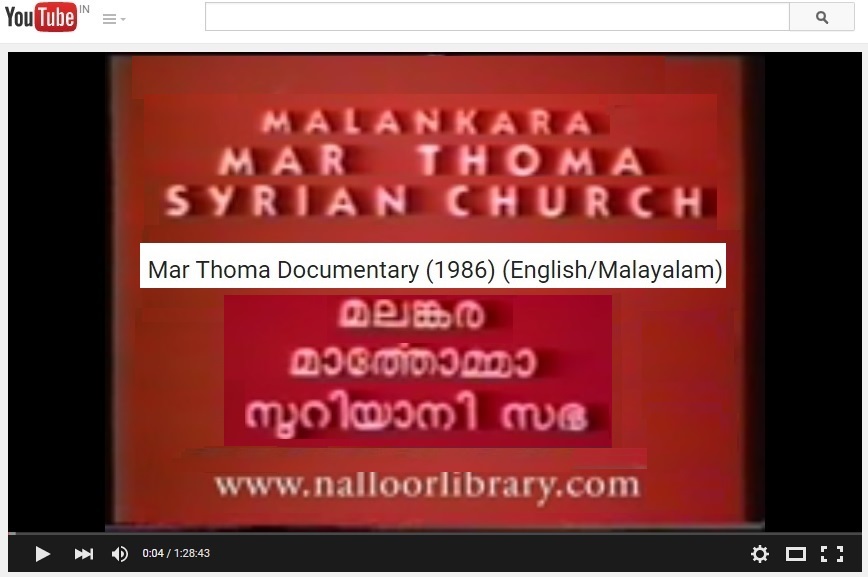
The Christian priest on the old now withdrawn Indian Rs. 500 note to represent Titusji the only Christian in the Dandi Salt March along with Mahatma Gandhi. (Currency note used for illustrative purposes only. The Rs. 500 note was discontinued in 2016)
Millions of Indians used the now discontinued Indian 500 Rupee note without giving too much notice to the image of the historic Dandi Salt march by Mahatma Gandhi in 1930 that triggered the wider Civil Disobedience Movement leading to India’s freedom from the British. The note may have gone, but the image of the marchers are alive and well in every India’s heart.
Among the marchers that would change India’s destiny was just one Christian and a Mar Thomite, Shri Thevarthundiyil Titus also known as ‘Titusji’. He is represented on the Indian Rs. 500 note as a “Christian Priest” (circled in blue in the image above). However he was sidelined and never received a pension from the Central Government, State Government or Freedom Fighter’s Associations. His own Church, the Mar Thoma Syrian Church seems to have no recollection of him or given him due recognition. Tituji’s home Parish, Maramon Mar Thoma Church or the Bhopal Parish St.Peter’s Mar Thoma Church which began in his residence have all but forgotten their illustrious son and his contribution to the nation’s freedom.
The image on the now discontinued Indian 500 Rupee note is that of a sculpture made in tribute of the march in the heart of the Indian capital city of Delhi, on the Sardar Patel Marg. The sculpture shows ten Indian people following Gandhi on his path-breaking civil disobedience protest, hence the name “Gyarah Murti” (Eleven Statues). The Christian priest was included to represent the only Christian in the march – Titusji. A devout Gandhian – he was known by the name Titus in his earlier days. “Titusji” was the name given to him by Mahatma Gandhi as a token of love and honour.

“Gyarah Murti” or “Eleven Statues with the priest highlighted in Red to represent Titusji who the lone Christian in the Dandi Salt March.
“Gandhi’s iconic retinue in the sculpture includes a woman with her head covered following close after him; a cluster of three men including a turbaned Sikh visibly of high pedigree, a Hindu scholar with a topi and an emaciated Muslim peasant; a Hindu man wearing a turban as a mark of intellectual distinction, with a religious mark etched on his forehead; an impoverished peasant looking far ahead, bearing no marks of class, caste or religion on his body; a Christian priest; another woman in a skirt and a young boy egging on a weary old man to travel farther.” ~ www.sodelhi.com
About Titusji
Titusji (b.18 Feb, 1905) hailed from a farming family, (Theverthundiyil, Maramon) in Kerala. He was a member of the Maramon Mar Thoma Parish. After his high school graduation, he taught in a school in Vadasserikkara (a village about 20 km away from Maramon), for a few years and then joined the Allahabad Agriculture University and cleared an Indian Dairy Diploma course with distinction.
Titusji-The Freedom Fighter
Gandhiji’s way of life, his principles and his simplicity greatly influenced Titusji that he decided to join Gandhiji’s Ashram named” Goshala “in Sabarmati. The lifestyle there was simple and austere, to say the least. All the inmates in the Ashram were allowed only two pairs of clothing and every one had to do his own chores. Early morning after prayers and two hours of charkha, each one was assigned his or her duties.He was selected by Mahatma Gandhi as a secretary for his milk project in the Sabarmati Ashram near Ahmedabad. Mr. Gulzarilal Nanda (who later became acting prime mister of India) was the secretary of another unit. Both of them were trusted friends of Gandhiji. Titus got married in 1933, to Annamma (Ikarethu House, Kozhencherry). Annamma, after her marriage, joined the Sabarmati Ashram and she donated her wedding ornaments to the Ashram. Gandhiji was very keenly interested in the activities of the dairy at the Ashram .It was in these formative years that Titusji got to know Gandhiji personally and his commitment to the freedom struggle was made stronger.
The Dandi March
.In 1930, when Mahatma Gandhi decided to break the salt law, he chose trusted Titus to be one of the selected 80 men. On March 12, 1930, Gandhi and 78 male satyagrahis set out, on foot, for the coastal village of Dandi, Gujarat, some 240 miles from their starting point in Sabarmati. Titusji was one of the satyagrahis who accompanied Gandhi in this historic event known as “Dandi March” or “The Salt Satyagraha.” Titusji was the only Christian in that group. They were beaten up and arrested by the British Police. Titusji was arrested during the march to the Dharasana Salt depot. He was initially imprisoned in the Jalalpur jail and subsequently shifted to the Nasik jail.
An interesting observation about Titusji’s participation in the Dandi march was that he was not wearing the Gandhi cap during the march. Apart from him, Gandhiji was the only other person who did not wear a cap. When some of the other marchers complained to Gandhiji about it, Gandhiji took the stand that no one should be compelled to wear one.
On being released from the prison, Titusji went back to the Sabarmati Ashram. In 1932 Gandhiji asked him to take charge of the ‘Goshala’ (Dairy farm) at the Ashram again. It was while he was here in 1933 that his marriage took place to Annamma, a caring, warm person who supported Titusji in all his difficult times.
Titusji’s eldest daughter Aleyamma was born when he was at Sabarmati Ashram. In 1933, Gandhiji suddenly decided to disband the Ashram .Gandhiji’s instructions to Titusji was that he take the entire cattle out of the Ashram and protect the cattle. Following Gandhiji’s orders, Titusji shifted all the cattle and staff members out of the ashram and took shelter in a Panjrapole (animal shelter). Titusji slept in the stables beside the cattle through out the monsoon He worked hard to keep up the various activities of the Goshala. It was a tough life but since hardships were a way of life, Titusji did not have any problem obeying such orders.
Mahatma Gandhi’s Visit to Kerala – 1934
During one of his visits to Travancore (Kerala) Titusji burnt British-made clothes (foreign clothes) in Kottayam and gave a fiery speech to thousands of Malayalees to join the freedom movement.
Mahatma Gandhi visited Titusji’s house in Maramon (Theverthundiyil) in 1934 on his way to the famous Hindu temple in Aranmula near Chengannur. He assured Titusji’s father that his son is safe and sound. This was considered one of the greatest events in Central Travancore. In and around Maramon, thousands witnessed his visit.
Involvement in Dairy
Gandhiji by this time was totally busy travelling the length and breadth of the country in mobilizing the masses for the cause of independence. In-spite of his hectic schedules he still took interest in the activities of the ‘Goshala’ (Dairy farm) and was in touch with Titusji. Gandhiji in one of his letters to Titusji in 1933 wrote “I wanted to come and see the ‘Goshala’ (Dairy farm), but it was impossible for me to spare the time during the few hours that I was in Ahmedabad….I knew however that you were working very hard to make the ‘Goshala’ (Dairy farm) a success and to keep it in a clean condition….. I want you to write to me from time to time telling me all about the progress of the ‘Goshala’ (Dairy farm).”
Then in the middle of 1935, Gandhiji decided to handover the entire ashram property including ‘Goshala’ (Dairy farm) to the Harijan Sevak Sangh and then the Sabarmati Ashram thereafter ceased to be the hub of activities as far as the freedom movement was concerned. Titusji then worked in various Dairy farms as Manager in different parts of India. Due to the frequent change of places, his elder children Aleyamma, Titus and Easow stayed with relatives in Travancore .Then during the time of independence he was in Delhi as Manager with Keventers Diary.
In the early 50’s, Titusji moved to Jabalpur and then to Bhopal. His family now included the addition of four more sons Joseph, George, John and Thomas. He had one daughter and six sons. He then took a job as a Manager in Bairagarh Dairy, Bhopal, Madhya Pradesh.
A couple of years later the Bairagarh Dairy closed down and the family had to go through a lot of hardships. Titusji had to sell off the family car and even his property in Maramon, Kerala. But he refused to ask for any special privileges as a freedom fighter. He then got a break by getting a Government job in Obaidullaganj as instructor in an Institute training Village Level Workers. It was a job of his liking. He stayed alone in Obaidullaganj and would return to Bhopal on Saturdays for the weekend and go back on Mondays. In those days a song sung by Mohammed Rafi ‘Suno suno ye Bapuji ki Amar Kahani ’was a favourite of his and used to be played in the Institute regularly.
The family kept shifting their residences in Bhopal from one rented house to another. After many ups and downs, Titusji managed to get a loan of Rs.16,000 and bought a piece of land in the Noor-Mahal area of Bhopal. The entire family worked hard to build the house which was promptly named ‘Lake View Cottage’ since it afforded a clear view of the Bhopal Lake. At that time, there were no other houses in the neighbourhood. The family shifted to this house in 1956.
In 1962, Titusji got a job in Bhilai Steel Plant establishing the dairy unit in the Bhilai Steel Plant Township. He arranged for the collection of milk from nearby villages and introduced for the first time pasteurization and bottling of milk with pilfer-proof aluminium foil using imported machines. This was then distributed to all the sectors of the township.
After retiring from Bhilai Steel Plant, Titusji worked with a Christian NGO in Siliguri, West Bengal. Later he shifted to Sodpur in 24 Parganas, West Bengal. Thereafter he served the World Council of Churches (Bengal Refugee Services) in Calcutta.
At this point of time he had to face personal loss. On 2nd of December 1964, his second son, 24 year old Joy suddenly had a heart attack in his office and died. The funeral was attended by thousands. But cruel fate had more in store for him. On 12th April 1965, barely two months after the sixtieth birthday of Titusji, his beloved wife Annamma passed away. She died of post operative complications after having undergone an operation for appendicitis.
Inspite of all the setbacks Titusji remained active in his work. He was selected by the Birla group for setting up a dairy in the township of Hindustan Motors in Uttarpara, near Calcutta. He did this successfully and then re-settled in Bhopal in 1972 for a quiet life with his children and grand children.
Titusji- A man of faith
Titusji had immense faith in God. This helped him to overcome the trials and tribulations in his life. His honest and simple way of life made it easier for him to lead the life of a true Christian. He believed in the dignity of the individual, irrespective of his or her origin or status. He strived to help the fellow human beings in which ever way he could. Titusji being one of the few Malayali gazetted officers in Bhopal in the early 50’s, helped many Keralites who used to come to him to get their certificates attested and also in case of other difficulties .His was one home to which people could turn to without hesitation and ask for any help. Annamma, his wife had this habit of visiting the nearby Government Hospital and offering food or any possible help to anyone needy. Having experienced tough days themselves, they knew the importance of helping out the unfortunate,the lesser privileged.
In Bhopal Titusji initiated the forming of a Christian Congregation. A few Marthomites who were in Bhopal in the fifties started the Sunday worship in October 1954 at the residence of Titusji. That was the beginning of the Bhopal parish and was a congregation of all Christian denominations except the Roman Catholics. As the number of members grew, the space became inadequate and the Sunday service was shifted to other spacious halls and later to local church buildings. He was an active and a well-known member of the St.Peter’s Mar Thoma Church, Bhopal. Titusji was the driving force behind the establishment of Christa Prema Kulam Mission Field at Sehatganj, which is on the Bhopal-Sagar National Highway, about 25 kms from Bhopal City. The land for the Ashram was given by him at a nominal cost.This mission field is currently doing commendable work in uplifting the condition of the rural people living in the area.
In 1970, he published the book “The Bharat of my Dreams” in which he revealed his hope for the nation,and for its teeming millions. He firmly believed that all are equal and hence there should not be any disparity.
He had one daughter and six sons. He passed away on 8 August, 1980, at the Kasturba Hospital in Bhopal and was buried in the Christian Cemetery there. He never got any medals or pension for his participation in the freedom struggle. We salute his humbleness, patriotism, and dedication to the nation.
It is a matter of great pride to the Mar Thoma Syrian Church that it had men of such vision like Titusji, who worked untiringly for the freedom of the country. We praise and thank God for such leaders like Mr. and Mrs. Titus of Bhopal on his death anniversary on 8th August and the country’s Independence Day on 15th August.
How can you not share this story with others. We hope that it will inspire more youth from our Church to be involved in nation building with selflessness and pure thoughts.
***
A short film by Prashant Sharma, capturing the spirit and energy of Dandi Marchers Sculptures’ Workshop 1 Team Members who came from all walks of life and from all over the world to make the ambitious Dandi Memorial Project a reality. The Dandi Memorial Sculptures’ Workshop is a project of the Ministry of Culture, Government of India, coordinated and implemented by IIT Bombay in association with an International Design Team.
*With inputs and photos from Ms. Renu Thomas, granddaughter of Titusji and Mr. & Mrs. John Titus (son and daughter in law of Titusji).










[…] Read more: Remembering the Mahatma of the Mar Thoma Church (Freedom Fighter) Rare Photos and Video […]